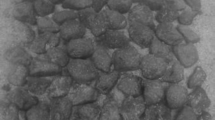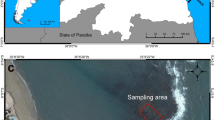Abstract
Tagged black-and-yellow rockfish Sebastes chrysomelas and gopher rockfish S. carnatus were observed in situ for 1 yr at 3 study sites off California, USA in order to determine the nature of their home ranges and territories. Three basic patterns of space use were identified: (1) a shelter hole located within a larger area of activity (in which the fish presumably fed, since its size increased with size of fish and decreased with prey density); (2) discontinuous home ranges, in which the shelter holes and feeding areas were separte; and (3) dispersed home ranges with little or no exclusive area. Fish in the first category were regarded as territorial, since their home ranges were defended and relatively exclusive. Because individuals did not patrol borders, however, territories often overlapped at their peripheries. In addition, some territory holders appeared to tolerate the sheltering of other fish within their territories, as long as these intruders left the territory during periods of activity. Some fish with discontinuous home ranges (“commuters”) may have been territorial, but others may have been forced to occupy suboptimal feeding areas. Fish in the third category (“floaters”) were regarded as nonterritorial; their activities were apparently limited to areas where they could escape the aggression of territory holders. The varying patterns appeared to develop through defense and accommodation during the turnover of individuals, with each fish securing shelter and feeding areas as these became available.
Similar content being viewed by others
Literature Cited
Baerends, G. P. and J. M. Baerends-von Roon: An introduction to the ethology of cichlid fishes. Behaviour Suppl. 1, 1–242 (1950)
Barlow, G. W.: Contrasts in social behavior between Central American cichlid fishes and coral-reef surgeon fishes. Am. Zool. 14, 9–34 (1974)
Barlow, G. W.: On the sociobiology of some hermaphroditic serranid fishes, the hamlets, in Puerto Rico. Mar. Biol. 33, 295–300 (1975)
Breder, C. M., Jr and D. E. Rosen: Modes of reproduction in fishes. 941 pp. Garden City, New York: Natural History Press 1966
Brown, J. L.: Aggressiveness, dominance and social organization in the Stellar's jay. Condor 65, 460–484 (1963)
Brown, J. L.: The evolution of behavior. 761 pp. New York: Norton 1975
Brown, J. L. and G. H. Orians: Spacing patterns in mobile animals. Ann. Rev. Ecol. Syst. 1, 239–267 (1970)
Buckman, N. S. and J. C. Ogden: Territorial behavior of the striped parrotfish Scarus croicencis Bloch (Scaridae). Ecology 54, 1377–1382 (1973)
Carlisle, D. B.: Intertidal territory in a fish. Anim. Behav. 10, 106–107 (1961)
Chen, L. C.: Systematics, variation, distribution, and biology of rockfishes of the subgenus Sebastomus (Pisces, Scorpaenidae, Sebastes). Bulletin of the Scripps Institution of Oceanography 18, 1–115 (1971)
Clarke, T. A.: Territorial behavior and population dynamics of a pomacentrid fish, the garibaldi, Hypsypops rubicunda. Ecol. Monogr. 40, 189–212 (1970)
Dell, M. B.: A new fish tag and rapid cartridge-fed applicator. Trans. Am. Fish. Soc. 97, 57–59 (1968)
DeMartini, E. E.: The adaptive significance of territoriality and egg cannibalism in the painted greenling, Oxylebius pictus Gill, a northeastern Pacific marine fish, 286 pp. Doctoral Dissertation, University of Washington 1976
Ehrlich, P. R.: The population biology of coral reef fishes. Ann. Rev. Ecol. Syst. 6, 211–247 (1975)
Feder, H. M., C. H. Turner and C. Limbaugh: Observations on fishes associated with kelp beds in southern California. California Department of Fish and Game, Fish Bulletin 160, 1–144 (1974)
Hallacher, L. E.: Patterns of space and food use by inshore rockfishes (Scorpaenidae: Sebastes) of Carmel Bay, California, 115 pp. Doctoral Dissertation, University of California, Berkeley 1977
Hinde, H. A.: The biological significance of the territories of birds. Ibis 98, 340–369 (1956)
Hixon, M. A.: Competitive interactions and spatiotemporal patterns among California reef fishes of the genus Embiotoca, 213 pp. Doctoral Dissertation, University of California, Santa Barbara 1979
Holmes, R. T.: Differences in population density, territoriality, and food supply of dunlin on arctic and subarctic tundra. In: Animal populations in relation to their food resources, British Ecological Society Symposium no. 10, pp 303–317. Ed. by A. Watson. Oxford: Blackwell Scientific Publications 1970
Hubbs, C. L. and L. P. Schultz: Descriptions of two new American species referable to the genus Sebastodes, with notes on related species. Univ. Wash. Publ. Biol. 2, 15–44 (1933)
Johnson, V. R., Jr.: Individual recognition in banded shrimp Stenopus hispidis (Olivier). Anim. Behav. 25, 418–428 (1977)
Kodric-Brown, A. and J. H. Brown: Influence of economics, interspecific competition, and sexual dimorphism on territoriality of migrant rufous hummingbirds. Ecology 59, 285–296 (1978)
Krebs, J. R.: Territory and breeding density in the great tit, Parus major L. Ecology 52, 2–22 (1971)
Larson, R. J.: The food habits of four kelp-bed rockfishes (Scorpaenidae, Sebastes) off Santa Barbara, California, 56 pp. Master's Thesis, University of California, Santa Barbara 1972
Larson, R. J.: Habitat selection and territorial competition as the causes of bathymetric segregation of sibling rockfishes (Sebastes), 170 pp. Doctoral Dissertation, University of California, Santa Barbara 1977
Larson, R. J.: Influence of territoriality on adult density in two rockfishes of the genus Sebastes. Mar. Biol. 00-00 (1980a)
Larson, R. J.: Competition, habitat selection, and the hathymetric segregation of two rockfish (Sebastes) species. Ecol. Monogr. 50, 221–239 (1980b)
McNab, B. K.: Bioenergetics and the determination of home range size. Amer. Natur. 97, 133–140 (1963)
Miller, D. J. and R. N. Lea: Guide to the coastal marine fishes of California. California Department of Fish and Game, Fish Bull. 157, 1–235 (1972)
Miller, G. R., A. Watson and D. Jenkins: Responses of red grouse to experimental improvement of their food. In: Animal populations in relation to their food resources, British Ecological Society Symposium no. 10, pp 323–335. Ed. by A. Watson. Oxford: Blackwell Scientific Publications 1970
Moser, H. G.: Reproduction and development of Sebastodes paucispinus and comparison with other rockfishes off southern California. Copeia 1967, 773–797 (1967)
Myrberg, A. A., Jr and R. E. Thresher: Interspecific agression and its relevance to the concept of territoriality in fishes. Am. Zool. 14, 81–96 (1974)
Noble, G. K.: The role of dominance in the social life of birds. Auk 56, 263–273 (1939)
Nursall, J. R.: Territoriality in redlip blennies (Ophioblennius atlanticus-Pisces: Blenniidae). J. Zool., Lond. 182, 205–223 (1977)
Phillips, J. R.: A review of the rockfishes of California (family Scorpaenidae). California Department of Fish and Game, Fish Bull. 104, 1–158 (1957)
Pitelka, F. A.: Numbers, breeding schedule, and territoriality in pectoral sandpipers of northern Alaska. Condor 61, 233–264 (1959)
Reese, E. S.: A comparative field study of the social behavior and related ecology of reef fishes of the family Chaetodontidae. Z. Tierpsychol. 37, 37–61 (1975)
Robertson, D. R. and J. M. Sheldon: Competitive interactions and the availability of sleeping sites for a diurnal coral reef fish. J. exp. mar. Biol. Ecol. 40, 285–298 (1979)
Robertson, D. R., H. P. A. Sweatman, E. A. Fletcher and M. G. Cleland: Schooling as a mechanism for circumventing the territoriality of competitors. Ecology 57, 1208–1220 (1976)
Sale, P. F.: The effect of territorial adult pomacentrid fishes on the recruitment and survival of juveniles on patches of coral rubble. J. exp. mar. Biol. Ecol. 24, 297–306 (1976)
Schoener, T. W.: Sizes of feeding territories among birds. Ecology 49, 123–141 (1968)
Schoener, T. W.: Theory of feeding strategies. Ann. Rev. Ecol. Syst. 2, 369–404 (1971)
Simon, C. A.: The influence of food abundance on territory size in the iguanid lizard Sceloporus jarrovi. Ecology 56, 993–998 (1975)
Slaney, P. A. and T. G. Northcote: Effects of prey abundance on density and territorial behavior of young rainbow trout (Salmo gairdneri) in laboratory stream channels. J. Fish. Res. Bd Can. 31, 1201–1209 (1974)
Smith, C. C.: The adaptive nature of social organization in the genus of tree squirrels Tamiasciurus. Ecol. Monogr. 38, 31–63 (1968)
Smith, S. M.: The “underworld” in a territorial sparrow: adaptive strategy for floaters. Amer. Natur. 112, 571–582 (1978)
Snedecor, G. W. and W. G. Cochran: Statistical methods, sixth edition. 593 pp. Ames, Iowa: Iowa State University Press 1967
Southwood, T. R. E.: Ecological methods. 391 pp. London: Methuen and Co., Ltd. 1966
Stenger, J.: Food habitats and available food of ovenbirds in relation to territory size. Auk 75, 335–346 (1958)
Stephens, J. S., Jr., R. K. Johnson, G. S. Key and J. E. McCosker: The comparative ecology of three sympatric species of California blennies of the genus Hypsoblennius Gill (Teleostomi, Blenniidae). Ecol. Monogr. 40, 213–233 (1970)
Stickel, L. F.: A comparison of certain methods of measuring ranges of small animals. J. Mammal. 35, 1–15 (1954)
Thompson, D. C.: The social system of the grey squirrel. Behaviour 63, 305–328 (1978)
Todd, J. H., A. Atema and J. E. Bardach: Chemical communication in social behavior of a fish, the yellow bullhead (Ictalurus natalis). Science 158, 672–673 (1967)
Turner, F. B., R. I. Jennrich and J. D. Weintraub: Home range and body size of lizards. Ecology 50, 1076–1081 (1969)
Weeden, J. S.: Territorial behavior of the tree sparrow. Condor 67, 193–209 (1965)
Weeden, J. S. and J. B. Falls: Differential responses of male ovenbirds to recorded songs of neighboring and more distant individuals. Auk 76, 343–351 (1959)
Willis, E. O.: The behavior of bicolored antbirds. Univ. Calif. Publ. Zool. 79, 1–127 (1967)
Wilson, E. O.: Sociobiology, the new synthesis. 697 pp. Cambridge, Massachusetts: Belknap 1975
Yamagishi, S.: A study of the home range and territory in meadow bunting (Emberiza cioides). Misc. Rep. Yamashima Inst. Ornithol. 6, 356–388 (1971)
Author information
Authors and Affiliations
Additional information
Communicated by I. Morris, West Boothbay Harbor
Rights and permissions
About this article
Cite this article
Larson, R.J. Territorial behavior of the black and yellow rockfish and gopher rockfish (Scorpaenidae, Sebastes). Mar. Biol. 58, 111–122 (1980). https://doi.org/10.1007/BF00396122
Accepted:
Issue Date:
DOI: https://doi.org/10.1007/BF00396122




